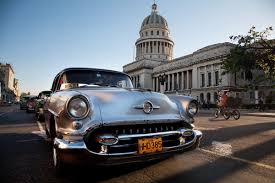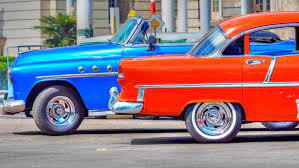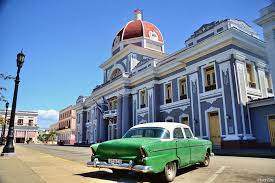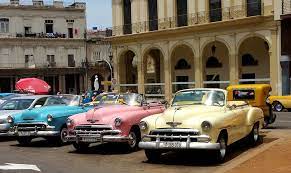
LOS “ALMENDRONES” (CARROS VIEJOS CLASICOS) CUBANOS, RELIQUIAS DEL PASADO. PHOTOS.
Los años 50 del siglo pasado es una época clave para ponernos en situación ante esta amplia galería de coches clásicos. La Habana era una ciudad al alza, donde el contrabando y el juego estaban al orden del día, como si fuera Las Vegas versión caribeña.
Tras la revolución de 1959 y el bloqueo estadounidense, los cubanos tuvieron que adaptarse a las circunstancias y aprendieron a reparar y mantener aquellos autos de los años dorados sin recambios ni piezas oficiales de las marcas. Todo un arte que hoy los convierte no en reliquias del pasado, sino en piezas de museo en movimiento.
Espectaculares Plymouth, Mercury, Oldsmobile, Ford, Cadillac, Chevrolet o Dodge circulan por La Habana como si no pasara el tiempo en este museo al aire libre
DE GENERACION A GENERACION EN CUBA
En general, este tipo de ‘carros’ clásicos pasan de generación en generación en la misma familia, puesto que en muchas ocasiones suponen el sustento, la forma de ganarse la vida en una isla que vive especialmente del turismo.
Este tipo de coches antiguos, grandes clásicos, circulan por toda La Habana, aunque en la calle José Martí o Prado a la altura del Capitolio es posible ver un gran número de estos vehículos que harán las delicias de cualquier aficionado al motor o a cualquier persona capaz de apreciar un pedazo de la historia aún viva y en movimiento.
El patrimonio histórico, arquitectónico y sobre todo cultural, expresado en la fusión entre europeos, africanos y aborígenes en un inicio, junto a otros componentes étnicos y culturales más contemporáneos, convierten a la ciudad de La Habana en una importante receptora de turismo internacional y en el centro de la vida nacional.
Su centro histórico, declarado Patrimonio de la Humanidad por la Unesco en 1982, es hoy uno de los conjuntos arquitectónicos mejor conservados de América Latina.
Entre sus monumentos más representativos se encuentran la Catedral de la Habana, la Plaza de Armas, el Castillo del Morro, el Museo de la Revolución, el Palacio Nacional de Bellas Artes, el Gran Teatro de La Habana, el Capitolio, la Plaza de la Revolución y el Malecón, quizás el símbolo más reconocido a nivel internacional de la ciudad.
Entre todos estos monumentos, los ‘carros’ clásicos, son tambien una joya nacional cubana.

RELIQUIAS DEL PASADO NACIONAL
Pero en Cuba no solo se han mantenido esos carros, se ha creado una especie de adoración hacia ellos, creando clubes. Ellos son el ‘Club de Autos Clásicos Británicos y Motos’, el ‘Club de VW Escarabajos de La Habana’, ‘Club de Autos Antiguos’, ‘Club de Motos Harley-Davidson’, ‘Club de Autos Clásicos A lo Cubano’, ‘Club Amigos del Motor de Cuba’ y hasta un ‘Club de Autos Rusos de Cuba’.
A este hecho, muy probablemente único en el mundo, le han dedicado artículos en revistas especializadas, reportajes, documentales y muchísimas historias en blogs personales y diarios.
Ejemplos de ello son History Channel con “Carros Americanos Clásicos de Cuba” muestra que Cuba ha hecho un homenaje lleno de amor a la edad de Oro de Detroit; Discovery Channel con la exitosa serie “Cuban Chrome”, un reportaje bien completo y objetivo; Full Galaxy realizó “Cuba sobre ruedas”, así como varios reportajes de Automotriz TV, Mekanikeando a lo Cubano, Cuba Classic Car Club “A lo Cubano”, y hasta se han filmado varias carreras ilegales de carros clásicos y motos y miles de otras producciones de aficionados. No en balde la octava parte de la saga fílmica norteamericana “Rápido y Furioso”, se filmó en La Habana.
En la actualidad en las imágenes utilizadas para las campañas turísticas de viajar a Cuba, junto a una mulata rumbera y una playa, tiene que aparecer sin falta un carro americano de los cincuenta.

THE CUBAN “ALMENDRONES” (CLASSIC OLD CARS), RELICS OF THE PAST. PHOTOS.
The 1950s are a key time to put ourselves in context with this wide gallery of classic cars. Havana was a city on the rise, where smuggling and gambling were the order of the day, as if it were the Caribbean version of Las Vegas.
After the 1959 revolution and the US blockade, Cubans had to adapt to the circumstances and learned to repair and maintain those cars from the golden years without spare parts or official parts from the brands. A whole art that today makes them not relics of the past, but moving museum pieces.
Spectacular Plymouths, Mercurys, Oldsmobiles, Fords, Cadillacs, Chevrolets and Dodges circulate through Havana as if time were standing still in this open-air museum
FROM GENERATION TO GENERATION IN CUBA
In general, these types of classic cars are passed down from generation to generation in the same family, since they are often the livelihood, the way of earning a living on an island that lives especially from tourism.
These types of old cars, great classics, circulate throughout Havana, although on José Martí or Prado streets near the Capitol, it is possible to see a large number of these vehicles that will delight any motor enthusiast or anyone capable of appreciating a piece of history that is still alive and moving.
The historical, architectural and, above all, cultural heritage, expressed in the fusion between Europeans, Africans and Aborigines at the beginning, together with other more contemporary ethnic and cultural components, make the city of Havana an important recipient of international tourism and the centre of national life.
Its historic centre, declared a World Heritage Site by UNESCO in 1982, is today one of the best preserved architectural complexes in Latin America.
Among its most representative monuments are the Havana Cathedral, the Plaza de Armas, the Morro Castle, the Museum of the Revolution, the National Palace of Fine Arts, the Grand Theatre of Havana, the Capitol, the Plaza de la Revolución and the Malecón, perhaps the most internationally recognised symbol of the city.
Among all these monuments, the classic cars are also a Cuban national jewel.
RELICS OF THE NATIONAL PAST
But in Cuba not only have these cars been maintained, but a kind of adoration for them has also created clubs. They are the ‘Club of British Classic Cars and Motorcycles’, the ‘Club of VW Beetles of Havana’, ‘Club of Antique Cars’, ‘Club of Harley-Davidson Motorcycles’, ‘Club of Classic Cars A lo Cubano’, ‘Club Amigos del Motor de Cuba’ and even a ‘Club de Autos Rusos de Cuba’.
Articles in specialized magazines, reports, documentaries, and many stories in personal blogs and newspapers have been dedicated to this fact, most likely unique in the world.
Examples of this are the History Channel with “Classic American Cars from Cuba” shows that Cuba has made a loving homage to Detroit’s Golden Age; Discovery Channel with the successful series “Cuban Chrome”, a very complete and objective report; Full Galaxy made “Cuba on wheels”, as well as several reports from Automotriz TV, Mekanikeando a lo Cubano, Cuba Classic Car Club “A lo Cubano”, and they have even filmed several illegal races of classic cars and motorcycles and thousands of other productions fans. Not in vain the eighth part of the North American film saga “Fast and Furious” was filmed in Havana.
At present, in the images used for tourist campaigns to travel to Cuba, along with a mulatto rumbera and a beach, an American car from the fifties must appear without fail.

Agencies/ Wiki/ LaVanguardia/ MemoriasCubanas/Carlos RodríguezB. / Internet Photos/ Arnoldo Varona.
TheCubanHistory.com
THE CUBAN HISTORY, HOLLYWOOD.



